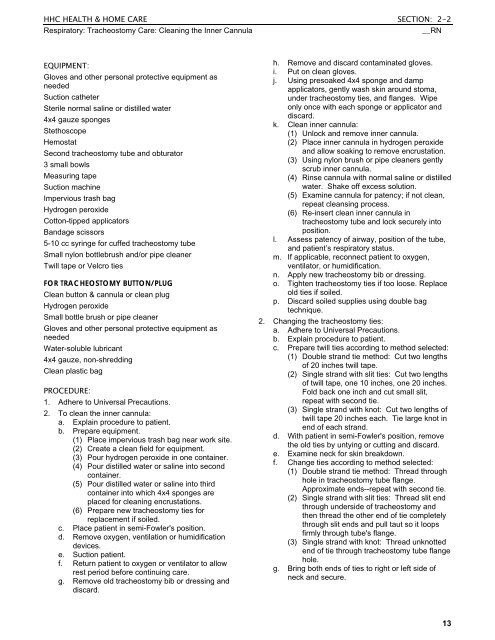HHC Health & Home Care Clinical Policy And
HHC Health & Home Care Clinical Policy And
HHC Health & Home Care Clinical Policy And
You also want an ePaper? Increase the reach of your titles
YUMPU automatically turns print PDFs into web optimized ePapers that Google loves.
<strong>HHC</strong> HEALTH & HOME CARE SECTION: 2-2<br />
Respiratory: Tracheostomy <strong>Care</strong>: Cleaning the Inner Cannula __RN<br />
EQUIPMENT:<br />
Gloves and other personal protective equipment as<br />
needed<br />
Suction catheter<br />
Sterile normal saline or distilled water<br />
4x4 gauze sponges<br />
Stethoscope<br />
Hemostat<br />
Second tracheostomy tube and obturator<br />
3 small bowls<br />
Measuring tape<br />
Suction machine<br />
Impervious trash bag<br />
Hydrogen peroxide<br />
Cotton-tipped applicators<br />
Bandage scissors<br />
5-10 cc syringe for cuffed tracheostomy tube<br />
Small nylon bottlebrush and/or pipe cleaner<br />
Twill tape or Velcro ties<br />
FOR TRACHEOSTOMY BUTTON/PLUG<br />
Clean button & cannula or clean plug<br />
Hydrogen peroxide<br />
Small bottle brush or pipe cleaner<br />
Gloves and other personal protective equipment as<br />
needed<br />
Water-soluble lubricant<br />
4x4 gauze, non-shredding<br />
Clean plastic bag<br />
PROCEDURE:<br />
1. Adhere to Universal Precautions.<br />
2. To clean the inner cannula:<br />
a. Explain procedure to patient.<br />
b. Prepare equipment.<br />
(1) Place impervious trash bag near work site.<br />
(2) Create a clean field for equipment.<br />
(3) Pour hydrogen peroxide in one container.<br />
(4) Pour distilled water or saline into second<br />
container.<br />
(5) Pour distilled water or saline into third<br />
container into which 4x4 sponges are<br />
placed for cleaning encrustations.<br />
(6) Prepare new tracheostomy ties for<br />
replacement if soiled.<br />
c. Place patient in semi-Fowler's position.<br />
d. Remove oxygen, ventilation or humidification<br />
devices.<br />
e. Suction patient.<br />
f. Return patient to oxygen or ventilator to allow<br />
rest period before continuing care.<br />
g. Remove old tracheostomy bib or dressing and<br />
discard.<br />
h. Remove and discard contaminated gloves.<br />
i. Put on clean gloves.<br />
j. Using presoaked 4x4 sponge and damp<br />
applicators, gently wash skin around stoma,<br />
under tracheostomy ties, and flanges. Wipe<br />
only once with each sponge or applicator and<br />
discard.<br />
k. Clean inner cannula:<br />
(1) Unlock and remove inner cannula.<br />
(2) Place inner cannula in hydrogen peroxide<br />
and allow soaking to remove encrustation.<br />
(3) Using nylon brush or pipe cleaners gently<br />
scrub inner cannula.<br />
(4) Rinse cannula with normal saline or distilled<br />
water. Shake off excess solution.<br />
(5) Examine cannula for patency; if not clean,<br />
repeat cleansing process.<br />
(6) Re-insert clean inner cannula in<br />
tracheostomy tube and lock securely into<br />
position.<br />
l. Assess patency of airway, position of the tube,<br />
and patient’s respiratory status.<br />
m. If applicable, reconnect patient to oxygen,<br />
ventilator, or humidification.<br />
n. Apply new tracheostomy bib or dressing.<br />
o. Tighten tracheostomy ties if too loose. Replace<br />
old ties if soiled.<br />
p. Discard soiled supplies using double bag<br />
technique.<br />
2. Changing the tracheostomy ties:<br />
a. Adhere to Universal Precautions.<br />
b. Explain procedure to patient.<br />
c. Prepare twill ties according to method selected:<br />
(1) Double strand tie method: Cut two lengths<br />
of 20 inches twill tape.<br />
(2) Single strand with slit ties: Cut two lengths<br />
of twill tape, one 10 inches, one 20 inches.<br />
Fold back one inch and cut small slit,<br />
repeat with second tie.<br />
(3) Single strand with knot: Cut two lengths of<br />
twill tape 20 inches each. Tie large knot in<br />
end of each strand.<br />
d. With patient in semi-Fowler's position, remove<br />
the old ties by untying or cutting and discard.<br />
e. Examine neck for skin breakdown.<br />
f. Change ties according to method selected:<br />
(1) Double strand tie method: Thread through<br />
hole in tracheostomy tube flange.<br />
Approximate ends--repeat with second tie.<br />
(2) Single strand with slit ties: Thread slit end<br />
through underside of tracheostomy and<br />
then thread the other end of tie completely<br />
through slit ends and pull taut so it loops<br />
firmly through tube's flange.<br />
(3) Single strand with knot: Thread unknotted<br />
end of tie through tracheostomy tube flange<br />
hole.<br />
g. Bring both ends of ties to right or left side of<br />
neck and secure.<br />
13







